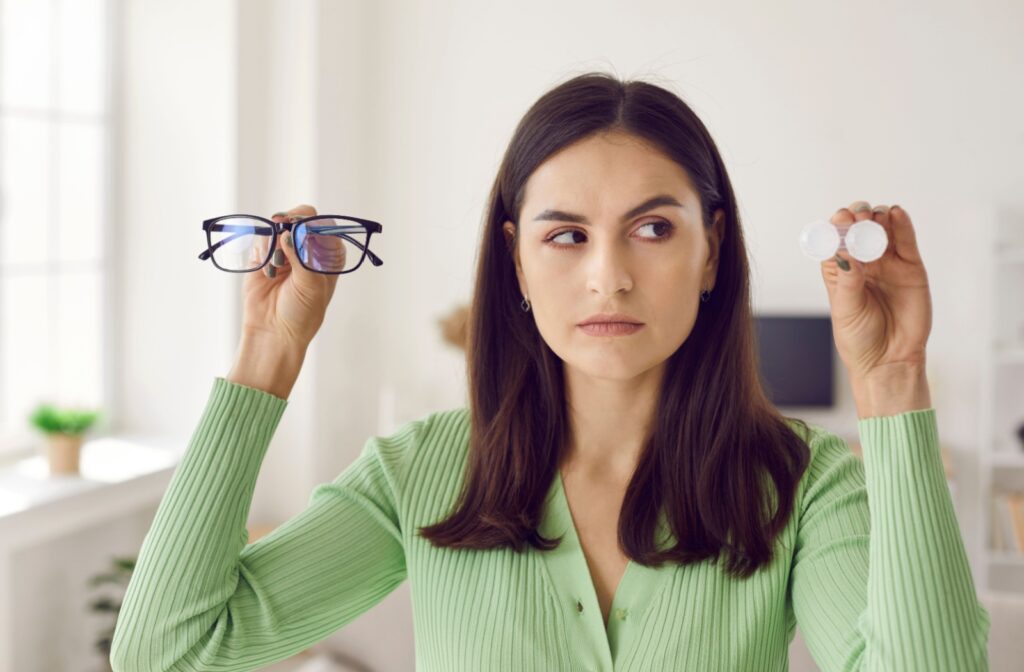Wearing contacts is meant to be convenient, but if you’re dealing with eye strain, it can be frustrating. Many people notice that their eyes feel more tired or uncomfortable with contacts than glasses.
This can happen for a few reasons, from dry eyes to screen time and even the fit of your lenses. While glasses rest comfortably on your face, contacts sit directly on your eyes, which can lead to different challenges.
Why Do Contacts Cause More Strain than Glasses?
Contact lenses sit directly on the eye’s surface, providing a seamless field of vision without the peripheral obstructions glasses might cause. Despite these advantages, they can also lead to more pronounced eye strain.
Unlike glasses, contacts can affect the eye’s moisture levels and oxygen supply, potentially leading to discomfort. The main difference lies in how each corrective method interacts with the eye’s physiology.
- Glasses rest on the bridge of the nose and have no direct contact with the sensitive ocular surface.
- Contacts must be fitted precisely to avoid irritation and maintain proper eye health, which can complicate their use compared to glasses.
Improper Lens Fit & Eye Strain
A poor fit is one of the most common causes of discomfort for contact lens wearers. If lenses are not correctly sized or shaped for your eyes, they can shift and cause irritation.
This mismatch can lead to a feeling of grittiness or a foreign body sensation, which is uncomfortable and can increase the risk of infections. Here are some tips to minimize discomfort:
- Ensure that an optometrist properly fits your lenses.
- Schedule regular check-ups to determine if the fit remains correct, as the shape of your eye can change over time or with varying environmental and health factors.
- Care for your contacts properly. Improper handling of contact lenses, such as not cleaning them adequately or wearing them longer than recommended, can intensify fitting issues and discomfort.
How Dry Eyes Contribute to Discomfort
Contact lenses can absorb moisture from the eye, which is necessary for maintaining comfort and clear vision. When the eye becomes too dry, the lenses can feel scratchy and uncomfortable.
Environmental factors, such as air conditioning or heating, can further dry out the eyes, aggravating existing conditions. People with naturally dry eyes may find contact lenses more challenging to wear comfortably, requiring specialized lenses designed to retain moisture better.
Using artificial tear drops and ensuring adequate hydration can help alleviate some of the dryness associated with contact lenses. Make sure you choose lens-friendly solutions to avoid damaging the lenses or irritating your eyes.

The Role of Screen Time in Contact Lens Strain
When focusing on a screen, whether a computer, phone, or tablet, people tend to blink less, which decreases tear production and distribution.
The blue light emitted by screens can also contribute to eye fatigue, making it harder for contacts to remain comfortable. Over time, this can lead to chronic discomfort and strain, further compounded by the drying effects of the lenses themselves. Here are some tips to help:
- The 20-20-20 rule—taking a 20-second break every 20 minutes to look at something 20 feet away—can help reduce eye strain.
- Using blue light filters or glasses can provide some relief from screen-induced fatigue.
Can Your Prescription Be the Issue?
Sometimes, eye strain can result from an incorrect prescription. If your contact lenses aren’t accurately correcting your vision, your eyes may work harder to focus, leading to strain and fatigue.
Regular eye exams are essential to ensure your prescription is suitable for your visual needs. Changes in eyesight can occur gradually, and without updated prescriptions, your contacts may not provide the correction needed.
Tips for Reducing Eye Strain with Contact Lenses
You can adopt several strategies to reduce eye strain while wearing contacts:
- First, ensure your lenses are clean and free from debris, which can cause irritation.
- Follow your optometrist’s guidance on lens care and replacement schedules.
- Take breaks from wearing contacts. Alternating with glasses allows your eyes to rest and reduces the constant pressure and potential dryness from all-day lens wear.
- Use lubricating eye drops specifically designed for contact lens wearers. These can help maintain moisture levels and comfort throughout the day, especially in dry environments or during prolonged screen use.
When to Consult Your Optometrist
If discomfort persists despite following best practices for lens care and usage, it may be time to consult your optometrist. Persistent eye strain or discomfort can indicate underlying issues needing professional attention.
Your optometrist can help you determine whether your lenses are the right fit and material for your needs and check for potential eye health issues. They can suggest alternative lens types or specialized solutions for managing dryness and strain.
Remember, prioritizing eye health is essential for ensuring a comfortable and effective experience with contact lenses. Book an appointment with Total Vision Long Beach to ensure your contacts are the right fit for you.



